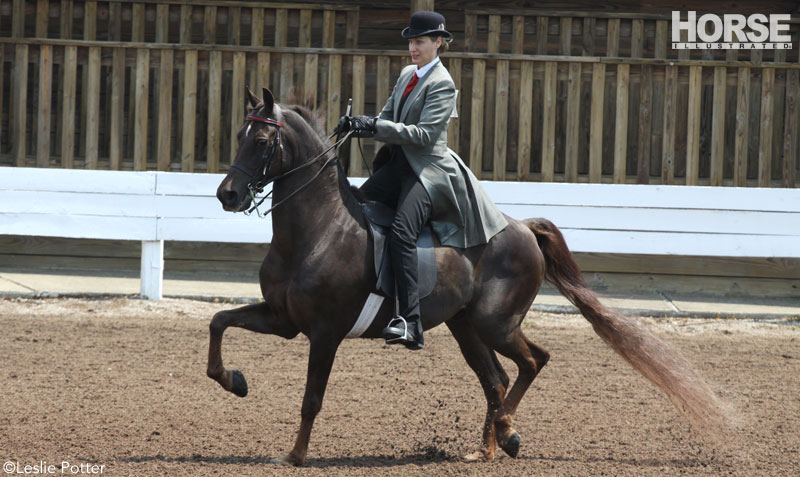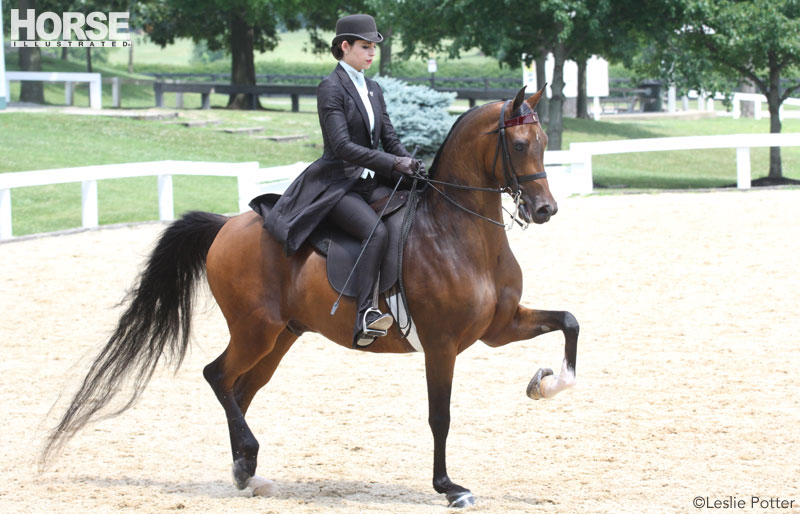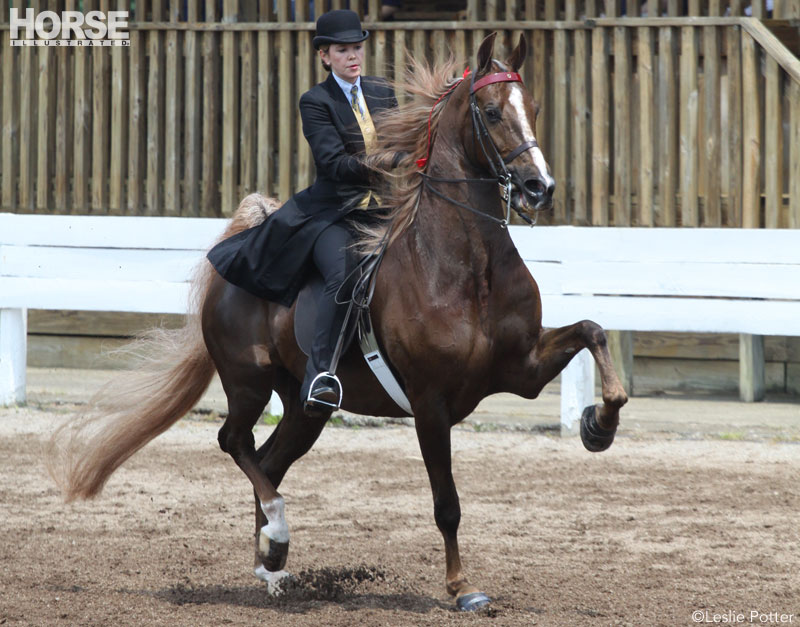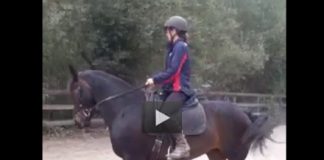The nuances of different saddle seat divisions may seem baffling to an outsider. But if you aspire to compete in this discipline, you need to determine the correct division for your horse. We asked professionals from the Morgan, Arabian and American Saddlebred breeds to help decode the class lists.

Morgans in the classic pleasure division should have impeccable manners and give the distinct impression of being a pleasure to ride.
A Pleasure Ride
In the Morgan world, classic pleasure is the name of the division for saddle seat horses with exceptional manners and a willing disposition. The equivalent for Arabians and Saddlebreds is country English pleasure. In these divisions, horses are judged first and foremost on their manners and obedience; they should appear to be a pleasure to ride. They need to have good gaits and be able to travel in a saddle seat frame, but the extreme animation seen in other divisions is less important here. For Morgans and Saddlebreds, these classes are restricted to amateur riders only.
Chris Cassenti, a Morgan judge and trainer at Chrislar Farm in Massachusetts, emphasizes that good manners come first in the Morgan classic pleasure division.
“When I am judging a classic pleasure class, it is important to me that the horse give the distinct impression of being a pleasure to ride, willingly performing each gait with smooth transitions,” says Cassenti. “The walk is of utmost importance, and standing quietly in the line-up and backing are imperative.” For Morgans, the rule book states that entries must be judged 40 percent on conformation, so Cassenti takes that into account as well.
Betsy Webb trains American Saddlebreds and teaches saddle seat riding at the Louisville Equestrian Center in Kentucky. She agrees that manners come first in the country pleasure division. “After [manners], we look for beauty, style and an easy way of going,” she says. “The country horse should give the impression that he would be nice to ride outside of the arena.”
Martha Murdock, an Arabian trainer and judge based in Paris, Ky., looks for a relaxed, comfortable ride from a country pleasure horse.
“I pay particular attention to the expression of both horse and rider,” she says. “I look for riders who are not tight in the arms as a result of the horses pulling them because they are heavy in the bridle.
“A true country horse will be relaxed and step softly into a canter with ease, not side-stepping or rushing,” continues Murdock. “I like a smooth canter that helps the rider to look comfortable.”
Arabians in the country pleasure division are required to halt on the rail, back, and walk off on a loose rein. This is a small part of the class, but one that can separate the winners from the also-rans. “I find that many times, a horse that performs out of balance and is not relaxed might halt and stand quietly, but he never backs up straight,” says Murdock. “More often than not, the back begins only after the horse tosses his head before that first step.”
Classic and country pleasure classes shouldn’t be considered a catch-all for horses that couldn’t make it in other saddle seat divisions. In fact, finding that perfect balance of manners and motion can be challenging, and not every horse will make the grade.
“A horse that doesn’t have a high-stepping trot can certainly win a classic pleasure class, provided that he has all of the other ingredients,” says Cassenti. “A horse with less motion but that performs with lots of presence, quality and willingness to perform each gait calmly is perfect for this division.”
Many amateur riders prefer to show horses in these divisions because they don’t require the upkeep that some of the more specialized horses do, and they can be ridden recreationally in between shows. For Morgans and Saddlebreds, there are restrictions on the type of shoeing that is allowed in these divisions, so you won’t see the weight or pads that sometimes appear in other divisions. (Click here to learn more about saddle seat shoeing regulations.)

For Arabians in the English pleasure division, there is a larger focus on consistent high motion than there is for their country pleasure counterparts.
Stepping Up
English pleasure can be a confusing title for riders coming to the breed circuits from local open shows. At riding clubs and schooling shows across the country, English pleasure classes are typically filled with hunt seat riders competing on the flat. However, for Morgan and Arabian exhibitors, English classes are strictly saddle seat. The Saddlebred equivalent is show pleasure, which is restricted to amateur riders and divided into three-gaited and five-gaited divisions. If your horse has plenty of natural action and energy, consider moving up to English or show pleasure.
“A show pleasure horse can have a little more power and motion [than a country pleasure horse],” says Webb. “He can be a little snappier in his gaits. You’re still looking for a well-mannered horse. Show pleasure horses don’t have to halt on the rail, but they still need to flat walk.”
“Attitude, training and balance point are the key differences between the English and country pleasure horses,” says Murdock. “The training for these divisions includes different degrees of intensity. In country pleasure, the focus will be on performing without error. In English, the focus is on consistent high motion.”
The English pleasure criteria for Morgans are similar.
“The English pleasure horse is a more bold-moving horse than a classic pleasure horse,” says Cassenti. “The horse must perform all gaits properly but may be more forward moving and higher stepping. The horse’s attitude and conformation play a big part in selecting the English pleasure horse.”
Shoeing regulations are less strict in these divisions. If your horse is a gifted mover, you can show him in plain, unweighted shoes, but know that you will probably be going up against horses with show shoes in these classes. Some shows will allow you to cross-enter between the pleasure divisions.
“A horse shod for the classic division, with enough natural motion and attitude can certainly compete in both [classic and English pleasure], particularly if the rider can ride the horse a little more boldly,” says Cassenti.
Park
In the days before sports cars, wealthy businessmen would show off their success by trotting their fanciest horses through the park. This is said to be the origin of the park division, where showing off is the name of the game.
For saddle seat riders, there’s nothing more exhilarating than taking a spin on a big-moving park horse. But not every horse is cut out for this division. Today’s park classes demand extreme natural action, typically enhanced by training and shoeing. That big motion requires a lot of energy, and the horses that excel in the park division tend to be hot.
“A park horse will have extreme knee and balanced hock action and that brilliant upheaded and tail-flagging look in the show-ring,” says Cassenti. “In my opinion, a park horse is born with these attributes and a good trainer and rider can put the whole package together.”
Judges will fault poor manners or attitude in the park division, but little mistakes that might cost a rider a ribbon in the pleasure divisions will not necessarily mar an otherwise good performance.
“In a park class, I do not like to see ears pinned or tail wringing, no matter how high a horse can trot,” says Murdock. “However, a single break of gait or a canter that is a bit strong should not eliminate a park horse from the winner’s circle.”

Park Saddlebreds are bold-moving, powerful show horses.
Park is the pinnacle of the saddle seat division for Arabians and Morgans. For Saddlebreds, the park classes bring in the bold, showy horses that tend to have more power than show pleasure horses but don’t fit the refined, swanlike mold of the three-gaited division (click here to read about the American Saddlebred three- and five-gaited performance divisions).
“A park horse should have quite a bit of power,” says Webb. “He should be just as much show horse as an open three-gaited or five-gaited Saddlebred. He can be a little less refined than the three-gaited horse, but could be a little stronger.”
Saddlebred park horses are not faulted for performing a two-beat “park walk” instead of a flat walk, and are not held to the same standard of manners as their pleasure counterparts, but they still must give the impression of controlled energy.
“Park horses shouldn’t go extremely fast, and they can do an animated walk,” says Webb. “But it should be a straight walk, not crooked. In park and in all the divisions, the horse should look like he’s giving his rider a pleasant ride.”
Like all high-performance horses, park horses often require more meticulous management than those in other divisions. For this reason, many park horses are kept in professional training.
“Most amateurs have a full-time job or attend school, which doesn’t allow them the time needed to work these horses regularly and to their peak,” explains Cassenti. “There are amateur riders who are certainly qualified to work these horses if time permits. However, park horses are elite athletes and are best maintained by a professional who does have the time, talent and experience needed. The park horse is like the Olympian of the Morgan breed. Olympians work all year long with professionals to bring them to the peak of their ability.”
With that in mind, a rider who is new to saddle seat and has park aspirations shouldn’t shy away from the division, if the proper instruction and support are there.
“In any division, success results from preparation,” says Murdock. “If a rider is prepared properly, I think it is possible to master any division. I have known many amateurs who started out [their show careers] in the park division riding seasoned horses who took them to top honors.”
Liked this article? Here are others on saddle seat riding:
Saddle Seat Equitation: Form to Function
Video: Adventures in Saddle Seat
How to Train Your Saddle Seat Horse at Home
LESLIE POTTER holds a B.S. in Equestrian Science with a concentration in saddle seat riding from William Woods University. Follow her on Twitter: @LeslieInLex.
This article originally appeared in the January 2013 issue of Horse Illustrated magazine. Click here to subscribe!






Oh my. I think I’ll stick to dressage.